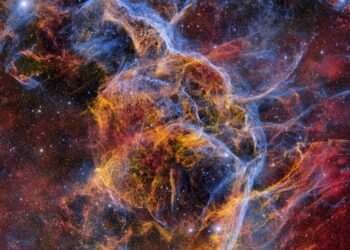A team led by astronomers at The Australian National University has discovered what they believe to be the oldest star in the known Universe – forming shortly after the Big Bang, some 13.7 billion years ago.
This is the first time astrophysicists get the chance to study the chemistry of the oldest stars, giving scientists a clearer idea of what the Universe was like in its infancy.
“This is the first time that we’ve been able to unambiguously say that we’ve found the chemical fingerprint of a first star,” said lead researcher, Dr Stefan Keller of the ANU Research School of Astronomy and Astrophysics. “This is one of the first steps in understanding what those first stars were like. What this star has enabled us to do is record the fingerprint of those first stars.”
The discovery was possible thanks to the ANU SkyMapper – a fully automated 1.35m wide-angle optical telescope at Siding Spring Observatory in northern New South Wales, Australia; the telescope was designed to look at the southern sky in search for ancient stars, as part of a five year project. So far, results are very encouraging.
The ancient star (SMSS J031300.36-670839.3) is 6.000 light years away from us – which is a huge distance in and of itself, but pretty close in astronomical terms. It is one of the 60 million stars photographed by SkyMapper in its first year, so it was quite the fortuitous find. SMSS J031300.36-670839.3 also has a much higher carbon supply compared to iron, more than a thousand times greater. Apart from hydrogen, which appeared in the Big Bang the star also contains carbon, magnesium, and calcium which could have been formed in a low energy supernova.
“The stars we are finding number one in a million,” says team member Professor Mike Bessell, who worked with Keller on the research. “Finding such needles in a haystack is possible thanks to the ANU SkyMapper telescope that is unique in its ability to find stars with low iron from their colour.”
The chemistry of primordial stars

Its chemical composition shows it formed in the wake of a primordial star, which had a mass 60 times that of our Sun – so it is basically a second-generation star. In case you’re wondering how astronomers study the chemistry of distant stars (since obviously they can’t go there and take samples), they do it through a technique called astronomical spectroscopy. In astronomical spectroscopy, the object of study is the spectrum of electromagnetic radiation, including visible light, which radiates from stars and other hot celestial objects; judging by the wavelength emitted by the star, a number of properties can be derived, including chemical composition, temperature, density, mass, distance, luminosity, and relative motion using Doppler shift measurements.
“To make a star like our Sun, you take the basic ingredients of hydrogen and helium from the Big Bang and add an enormous amount of iron – the equivalent of about 1,000 times the Earth’s mass,” Dr Keller says. “To make this ancient star, you need no more than an Australia-sized asteroid of iron and lots of carbon. It’s a very different recipe that tells us a lot about the nature of the first stars and how they died.”
It was previously believed that primordial stars didn’t survive the early period of the universe – disappearing in extremely violent explosions which polluted huge volumes of space with iron. But the ancient star shows signs of pollution with lighter elements such as carbon and magnesium, and no sign of pollution with iron.
“This indicates the primordial star’s supernova explosion was of surprisingly low energy. Although sufficient to disintegrate the primordial star, almost all of the heavy elements such as iron, were consumed by a black hole that formed at the heart of the explosion,” he says.
Scientific Reference:






